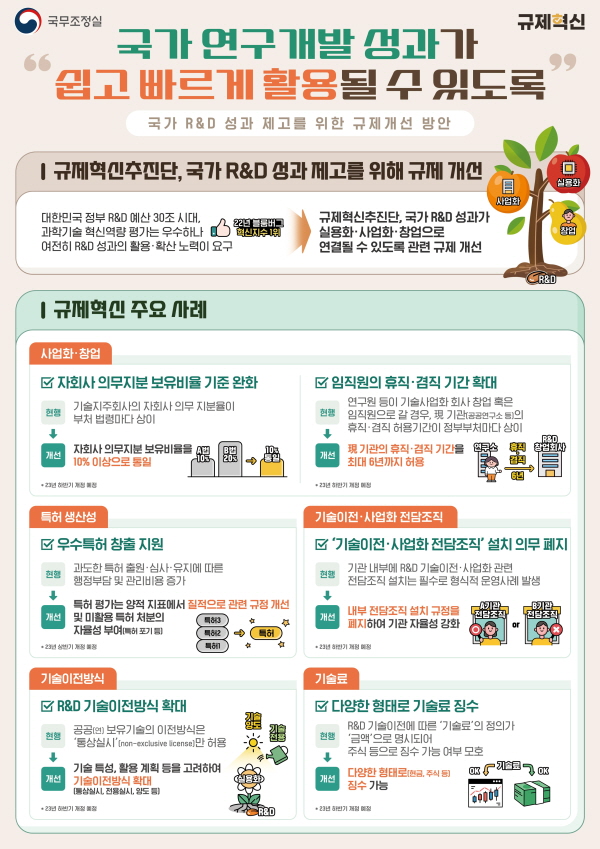기술지주회사의 자회사 의무지분 보유 비율이 20%에서 10%로 완화되는 등 신기술 창업기업에 대한 투자가 쉬워지도록 기술이전, 사업화, 창업성장을 가로막는 규제 개선에 정부가 본격 나선다.
과도한 특허출원 막고·미활용 특허 자율성 부여
기술이전 촉진 및 수요자 지재권 확보·행사 보장
기술지주회사의 자회사 의무지분 보유 비율이 20%에서 10%로 완화되는 등 신기술 창업기업에 대한 투자가 쉬워지도록 기술이전, 사업화, 창업성장을 가로막는 규제 개선에 정부가 본격 나선다.
국무조정실 규제혁신추진단은 6개 관계 부처(과기정통부, 산업부, 교육부, 중기부, 기재부, 특허청)와 함께 마련한 ‘국가R&D 성과 제고를 위한 규제개선방안’을 규제개혁위원회에 보고하고, 각 부처는 이를 추진하기로 하는 등 국가R&D 성과의 활용·확산을 방해하는 각종 규제 해소에 나선다고 최근 밝혔다.
추진단은 한국과학기술기획평가원(KISTEP), 과학기술정책연구원(STEPI) 등 관계기관과 함께 연구 및 기업현장으로부터 연구성과의 활용·확산을 가로막는 생생한 규제사례를 발굴해 개선방안을 검토했다.
이에 따르면 △연구원 창업 및 창업 이후 성장·지원 △창업을 위한 휴·겸직 허용기간 확대 △특허 생산성 제고 △기술이전·사업화 전담조직의 설치·운영 애로해소 △공공(연) 기술이전방식 전면 개편 △기술료 징수·납부·사용기준 완화 등 6가지를 중점적으로 검토했고, 그 결과 15개 규제의 개선방안을 마련했다.
우선 공공R&D 결과를 바탕으로 한 사업화 또는 창업활동을 위축하거나 이후의 지속적인 성장을 저해하는 규제를 개선한다.
공공 R&D성과의 사업화를 위한 기술지주회사 및 자회사 주식 보유비율 등이 관련 법령마다 상이하고 경직되게 운영됨에 따라 투자유치 활동 등에 장애요인이 되고 있고 현장 적용에도 혼란을 초래해 관련 법령마다 상이한 자회사 주식 보유비율을 10% 이상으로 완화해 통일하는 한편, 투자유치 활성화 지원을 위하여 산학연협력기술지주회사의 경우 총 자본금의 30% 현물(기술) 출자비율을 최초 설립할 때만 적용하기로 했다.
임·직원의 기술사업화·창업을 위한 휴직·겸직 등 허용 기간이 정부부처(과기정통부, 산업부, 중기부, 교육부) 마다 상이해 현장 적용에 혼란을 준 것에 대해서는 공공(연) 창업기업의 상임·비상임 임원은 물론 직원으로까지 확대하고, 최대 6년까지 휴·겸직 허용하되 세부 절차는 기관 자율에 위임하기로 했다.
우수특허 창출 등을 위해 ‘특허가치 평가결과에 대한 품질관리체계를 구축’하는 한편 미활용 특허처리에도 자율성을 부여한다.
특허출원전 사전심의제도 운영 등 노력에도 불구하고, 과도한 특허 출원·심사·유지에 따른 행정부담 및 관리비용 증가 등 문제가 발생하고 있고 미활용 특허 포기 시 중앙행정기관장의 승인 규정 등에 따른 행정부담 가중은 물론 포기 지연에 따른 불필요한 유지비용 지출이 있었던 것에 대해서는 질적 평가와 사전·사후적 특허 관리 강화하기 위해 ‘국가R&D 평가 표준지침’ 개정 및 ‘대학·출연(연) 연구지원체계평가’에 반영하고, 특허포기를 포함해 대학·출연(연) 등이 보유한 지식재산의 유지·관리를 기관 자체적인 기준과 절차에 따라 추진할 수 있도록 자율성을 부여한다.
기관의 특성에 따라 기술이전·사업화 전담조직 설치 의무화를 폐지해 내외부 자원을 유연하게 활용할 수 있도록 했다.
기관 특성을 감안하지 않은 기술이전·사업화 내부 전담 조직 설치 의무화에 따라 수요가 적은 기관의 경우 유명무실화되거나 형식적 운영사례가 빈발했던 점에 있어서는 공공(연)이 기관특성 및 역량에 맞게 내·외부자원을 유연하게 활용할 수 있도록 전담조직 운영의 자율성을 강화하고 공공(연) 내부전담조직 설치 의무화 규정을 폐지하기로 했다.
R&D성과 보유기관이 기술의 특성 및 기업 수요 등을 고려하여 기술이전방식을 자율적으로 결정하도록 허용하기로 했다.
기술이전법에 따른 ‘공공R&D 성과물의 통상실시(non-exclusive license) 원칙’으로 인한 독점적 권리행사 어려움 등은 결과적으로 기술이전의 장애 요인이 되고 있는 것에 대해 공공(연) 보유기술의 통상실시(non-exclusive license) 원칙을 폐지하고, 기술 특성, 활용계획 등을 고려하여 통상실시, 전용실시, 양도 등 이전방식을 자율 결정하기로 했다.
기술이전에 따른 기술료 징수, 납부 및 사용 등과 관련해 연구현장에서 제기되는 규제를 해소함으로써 행정부담 및 혼란을 최소화한다.
국가연구개발혁신법 제정·시행으로 경상기술료 기준 납부방식, 금액으로 포괄적으로 명시된 기술료의 정의, 사용기준 등이 변경되면서 현장에서의 혼란을 초래하고 불필요한 행정부담 과중되고 있는 점에 대해서 매년 발간되는 국가연구개발혁신법 매뉴얼에 불확실한 점들을 명확하게 반영함으로써 연구현장의 혼란 및 불필요한 행정부담을 경감한다.
추진단 관계자는 “추진단은 앞으로도 관련부처 공동으로 국가R&D 성과제고, 특히 창의적·혁신적 연구몰입 환경 조성 및 신기술·신산업 활용을 가로막는 규제를 적극 발굴·개선해 나갈 계획”이라고 전했다.
